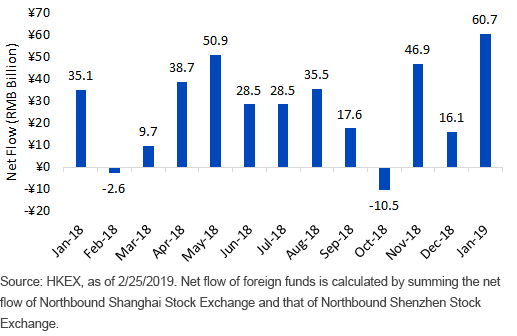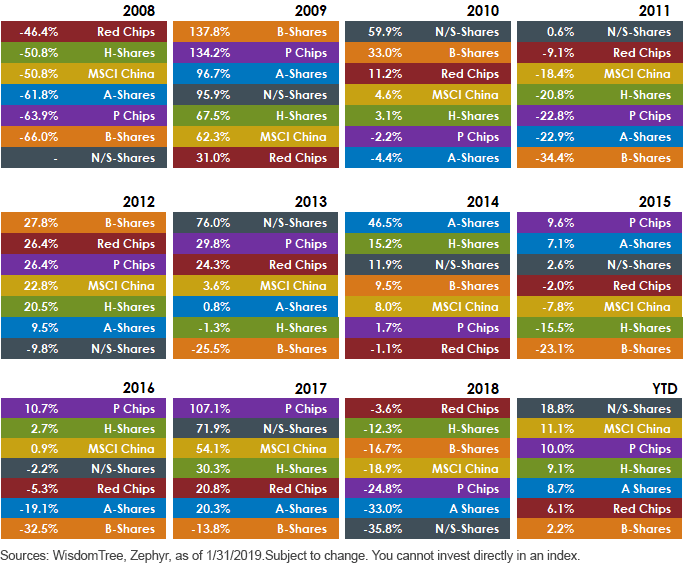How To Position For A Rebound In China
Chinese equities have ripped higher this year, and we see catalysts to support further gains.
MSCI recently announced plans to add more Chinese A-share stocks to its traditional China-focused indexes and to its broader emerging market and regional indexes. We think this will add further buying momentum to Chinese equities throughout the year.
Chinese A-shares currently have only a 5% inclusion factor in their indexes—but MSCI is upping the A-shares’ weight in three equal tranches to 20% by the end of November.
This adds to a few other catalysts for potential outperformance of Chinese equities:
1. U.S.-China Trade Deal: Pessimism about a long-lasting trade war has abated. While there are fundamental differences in the worldviews of the U.S. and China, we believe President Trump is likely to follow a similar approach with China to the one he used in negotiating trade deals with Canada and Mexico—particularly after his “no deal” discussion with North Korea.
2. Chinese Stimulus: Concerned about the slowdown of GDP, the Chinese government has taken several measures to stimulate growth by increasing liquidity and borrowing. In Q4, China launched the targeted medium-term lending facility (TMLF), which offers a lower interest rate than the existing medium-term lending facility (MLF) to specifically support small and private firms’ growth. In January 2019, the People’s Bank of China took further steps to release $116 billion into the market by cutting required reserve ratios by 100 basis points (bps).1
3. Federal Reserve (Fed) Pause: The Fed has lowered its expectations for the pace of rate increases this year. Similar to the 2016 pause, we believe risk assets can continue to rally as fears of a recession are pushed into the future.
Tracking Money Flows into China
While 2018 was a disappointing year for returns, China’s Stock Connect program was a huge success. In the chart below, we track net flows from foreign investors into Chinese stocks on mainland exchanges.
Net Flow of Foreign Investments through Stock Connect Program

With many investors needing to continue to buy mainland shares due to MSCI China benchmark changes, we believe flows into A-shares will continue to accelerate. And we believe investors should be over-weight A-shares as demand continues to increase.
Chinese Beta
While many investors spend a great deal of time deciding when and if to go over-weight China, we believe they often make a mistake about how to access this market.
We think China remains in the early innings of its path to financial market liberalization. Many index providers have a different definition of which types of Chinese stocks should be eligible for inclusion. So Chinese beta could be composed of seven share classes trading on four different exchanges.
Due to companies’ decisions about where to incorporate and list their stock for trading, each share class has its own distinct characteristics. As we show below, this can lead to a wide dispersion of returns.

For definitions of terms in the chart, please visit our glossary.
In our view, investors seeking broad-based exposure to China should consider a total market access product across all listings—something like the S&P China 500 Index.
By including all available share classes, investors are able to allocate to China in the same way they benchmark to U.S. markets via the S&P 500 Index strategies.
S&P China 500 Index vs. MSCI China Index
When it comes to Chinese beta, many investors have defaulted to the MSCI China Index. However, our view is the S&P China 500 Index gives a more accurate measure of the Chinese market not only by offering comprehensive coverage of all Chinese share classes but by taking a large stake in A-shares.
Comparing to MSCI China’s current 2.25% weight in A-shares, the S&P China 500 Index’s 50.76% weight indicates its focus on the Chinese domestic market. While MSCI just recognized A-shares’ value with the announcement to increase their weight to 20% in November, the S&P China 500 Index has already incorporated A-shares as an essential component.

The fundamentals between the S&P China 500 Index and the MSCI China Index are similar. However, across the board, the S&P China 500 Index has had higher value, better quality and a lower price.

For investors looking for a broad access vehicle to Chinese equity beta, WisdomTree launched a Fund to track the S&P China 500 Index—WCHN, the WisdomTree ICBCCS S&P China 500 Fund. MSCI is adding more A-shares this year and will have to continue to creep higher in their exposure, but our fund is already positioned across all the Chinese stocks.
1Source: Kevin Yao, Lusha Zhang, “China Slashes Banks’ Reserve Requirements Again as Growth Slows,” Reuters, 1/4/19.
Disclaimer: Investors should carefully consider the investment objectives, risks, charges and expenses of the Funds before investing. U.S. investors only: To obtain a prospectus containing this ...
more


